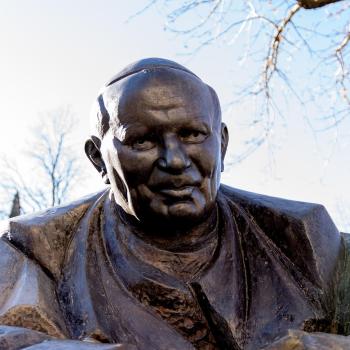THE QUESTION:
Why is January 1st New Year’s Day?
THE RELIGION GUY’S ANSWER:
There’s a religious angle here, as with almost any major aspect of human culture past and present. Our January 1 observance stems from ancient paganism. The numbering of “2021,” as with every year, reflects the global reach of Christianity. And the specific day everyone reckons to be January 1 was fixed by the Catholic Church during the Reformation and Counter-Reformation hostilities.
Alongside this conventional calendar, many faiths observe their own religious new years by calculations apart from the January 1 tradition.
The perpetually valuable Encyclopaedia Britannica tells us that worship of the Roman god Janus, with his festival (on January 9th, not the 1st) in the month eventually named for him was practiced even before the legendary founding of the city of Rome in 753 B.C. Janus was the animistic divinity of doorways (januae) and archways (jani). The idea of auspicious entrances and exits, endings and beginnings, eventually applied to turn of the year. January 1 officially replaced March 1 as the start of Rome’s year in 153 B.C..
Due to this pagan background, much of Christian Europe came to reject January 1 observances and celebrated the new year on Christmas Day or March 25, the feast of the Annunciation (the angel Gabriel’s message to Mary that she would bear the divine Son).
The year is the length of time the earth makes one circuit around the sun, but the day upon which a year begins is an arbitrary choice. In 46 B.C., Julius Caesar kept Rome’s January 1 starting point but reworked the “Julian calendar” to better fit with astronomy. The Julian system gained widespread use all the way until A.D. 1582, when Pope Gregory XIII ordered the “Gregorian calendar” cleanup that is universal today.
The Julian system figured that a year lasts roughly 365 days plus 1/4 of a day, so it added one day in the “leap year” every four years. However, this imperial system was 11 minutes and 14 seconds longer than the precise sun-orbit year of 365.2424 days, so things gradually got out of whack. The 16th Century papacy solved that by deleting certain leap years (including 2000). Not bad, but they tell us that by A.D. 4818 the calculation will be off by one day. Gregory’s shuffle erased some days forever. October 4 was followed directly by October 15. The papal decree also regularized January 1 as the start of the new year.
The result was international confusion due to religious rivalry. Protestant and Eastern Orthodox lands mostly refused to acknowledge papal authority even on such a common-sense matter. Britain and its North American colonies refused to go Gregorian until 1752, and Orthodox Russia remained Julian until the Communist Revolution that overthrew the dynastic czars went Gregorian, which meant the “October Revolution” occurred in November.
Dividing the year into weeks of seven days is another arbitrary construct with no relation to astronomy, and there were weeks of various lengths in ancient times. The week of seven days in the Ten Commandments of biblical Judaism was taken worldwide by Christianity.
In 1929, the atheistic Communists established the Soviet Eternal Calendar, which proved no more eternal than the Soviet Union itself. It set a five-day week so factories could run non-stop with staggered shifts, which scrambled family life and Sunday worship. The system was so hated that the Soviets tried a six-day week, then finally adopted the customary seven days in World War Two.
In 1912, China became another of the last lands to adopt the Gregorian calendar when the old dynasty gave way to the republic led by its first President Sun-yat Sen, a Christian convert. Though that was the civil calendar, the Chinese New Year several weeks later remained a popular festival.
Later yet, two Muslim nations agreed to go Gregorian, Turkey in 1927 and Saudi Arabia in 2016, which till then used the Islamic religious calendar for civil purposes. The Islamic calendar has a short year because months strictly follow the rising of the moon and the sun-based year is ignored. Therefore the new year on the first day of the month of Muharram floats backward year by year. Another complication is that for believers who rely upon traditional naked-eye sightings instead of astronomic calculations, the new year cannot be fixed as a single date in advance.
Reviewing other calendric basics, a year is conventionally designated as B.C. — meaning “Before Christ,” signifying that the coming of Jesus Christ is the hinge of human history — or A.D., from the Latin Anno Domini meaning ‘the year of the Lord.” Actually, Christ was born “Before Christ” (!) due to the consensus of modern experts on when King Herod the Great died, because the Nativity occurred under his rule. For non-Christian and non-partisan scholarship purposes, years are often designated as either B.C.E. (“Before Common Era”) or C.E. (“Common Era”).












